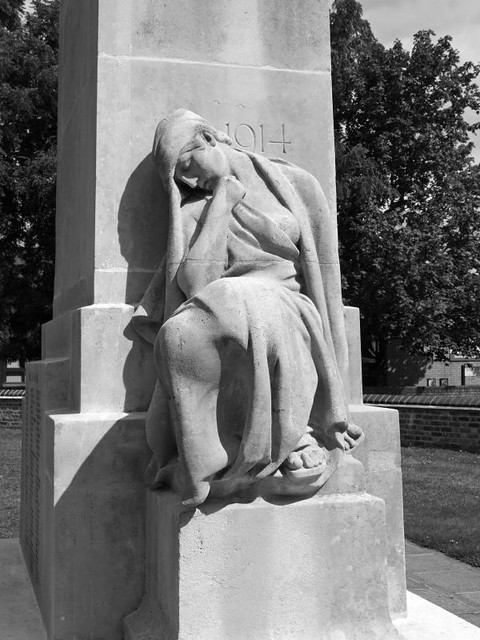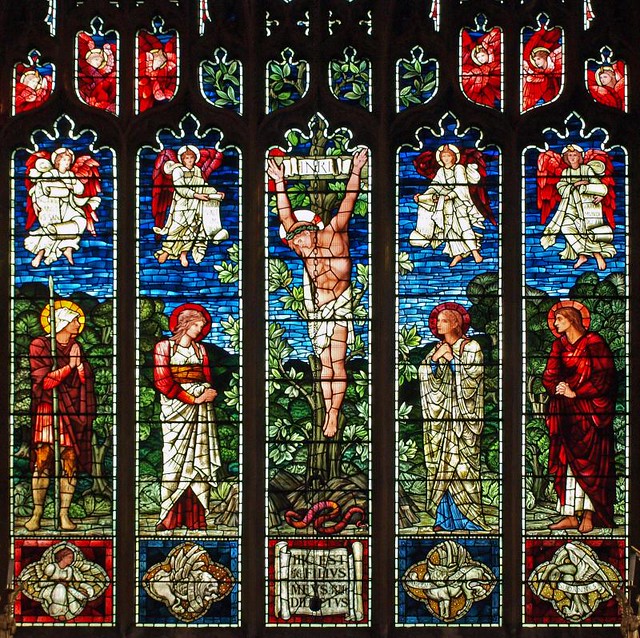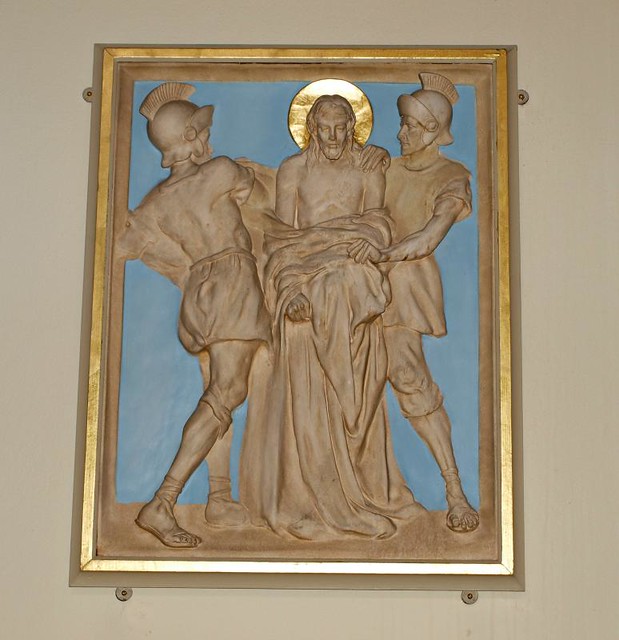St Mary, very open, is a Victorian concoction having been rebuilt in 1826 and then almost totally refurbed by Blomfield in 1890 and as such is the sort of Legoland Gothic revival church you'd expect - except it's rather good and the Burne-Jones east window is quality.
The exterior is almost impossible to successfully photograph, at least in summer, since it's surrounded by mature trees.
ST MARY. Rebuilt in 1826 and again in 1890. The architect then was Sir Arthur Blomfield. To him belongs everything we see now except the yellow brick aisles with their typical Early Gothic Revival windows, and the W tower which was kept from an earlier building of 1630. It has thick clasping buttresses, battlements, and a spike in the Herts tradition. Blomfield’s interior has the octagonal piers and two-centred arches of the county, and a clerestory. - STAINED GLASS, E window with Crucifixion by Burne-Jones, 1891. - PLATE. Chalice and Paten, 1509; Chalice and Paten, c. 1600; Chalice and Paten, 1628; Salver, 1692; Flagon, 1695. - MONUMENTS. Brass to Thomas Day and wives d. 1613 (N aisle). - Plain tombchest of Henry Cary, Earl of Monmouth d. 1661. - Epitaph to Sir Thomas Fatherley; later C17, with fine ornamentation.
Rickmansworth. Three rivers meet here, the Colne, the Chess, and the Gade, and as if they were not enough the Grand Union Canal passes the town on its way north. It has lovely riverside walks, fine open spaces, and a noble avenue of great trees. In the High Street are still a few of the old houses, among them Basing House, where William Penn brought his bride Gulielma Springett soon after their marriage. Here they lived four years. The charming timbered house called the Priory is much as they would see it, and so is the manor house, with its old chimneys, staircases, and panelling. The vicarage they would know has changed much, and has on it the date 1737, but it is one of the oldest in Hertfordshire, for it has Tudor ornament in a gable and timbers older still. The most famous house at Rickmansworth has been surrendered to the golfers, so that we may hope that this magnificent domain is safe from spoiling.
It is Moor Park which was given to the Earl of Oxford as a reward for his services on Bosworth Field, where the end of the march of Richard III gave Shakespeare the chance to say, “The day is done, the dog is dead.” After that Moor Park passed to Cardinal Wolsey, and after Wolsey’s fall it passed to the Earls of Monmouth, and finally to the Duke of Monmouth, who began building the house we see. He was, of course, the son of Charles II, and he dreamed of a great house and a throne. Both dreams were broken, for all the world knows how this most wretched man was dragged from a ditch after the Battle of Sedgemoor and beheaded on Tower Hill. As for his house, it was taken over in course of time by Benjamin Styles, who had grown rich in the South Sea Boom. He lavished a king’s ransom on Moor Park, spending £130,000 on it, engaging Sir James Thornhill, who had painted the dome of St Paul’s, to do the painting for him. After his day came Admiral Anson, who spent another £80,000, which he could well afford to do as he went round the world in 1744 and came home with £500,000 in Spanish treasure, and three years later seized £300,000 more from the French. The house has had its adventures since, but it has kept its grand portico with columns 50 feet high, the enormous hall with five marble doorways, and the original panels on the walls. And, whatever else it may lose, it must for ever keep the noble view from the highest point of the park, marked by a clump of noble trees. It is an unforgettable panorama.
The great tomb of the Monmouths is the chief monument in the church. In the tomb sleep the two earls, Robert Carey and his son Henry. They were strangely different characters, Robert, the son of a cousin of Queen Elizabeth I, soldier and courtier, who was present in the last dramatic days of Queen Elizabeth when she lay refusing to die; it was he who rode in haste to Holyrood to tell King James of Scotland that he was now King of England, so launching the Stuart dynasty on its tragic way. James promised him much and gave him little, and at last he became chamberlain to Prince Charles, who made him an earl when he came to the throne. Henry Carey, though brought up in the gilded atmosphere of the court, loved most the quiet of the study, spending life translating histories of foreign lands while the history of his own was being written in blood.
Above the Monmouth tomb is a tablet to Sir Thomas Fotherley, who was active in the service of Charles I. There is a brass from those days showing Thomas Day with his two wives.
The church itself is mostly modern, rebuilt in 1890, but there remains the handsome 17th-century tower that William Penn would know, with its medieval wooden window tracery and its evil-looking gargoyles, and it has still the little spire the 17th century gave it.
The memorial to the men of Rickmansworth who never came back is set at a meeting of the roads with a background of trees; it has an upraised lion on a high pedestal, with a seated figure of Victory holding up a laurel wreath. Another memorial of much interest has been set up in the forecourt of Joan of Arc Convent School, where a statue of Joan was unveiled by the French ambassador in 1939.
It is Moor Park which was given to the Earl of Oxford as a reward for his services on Bosworth Field, where the end of the march of Richard III gave Shakespeare the chance to say, “The day is done, the dog is dead.” After that Moor Park passed to Cardinal Wolsey, and after Wolsey’s fall it passed to the Earls of Monmouth, and finally to the Duke of Monmouth, who began building the house we see. He was, of course, the son of Charles II, and he dreamed of a great house and a throne. Both dreams were broken, for all the world knows how this most wretched man was dragged from a ditch after the Battle of Sedgemoor and beheaded on Tower Hill. As for his house, it was taken over in course of time by Benjamin Styles, who had grown rich in the South Sea Boom. He lavished a king’s ransom on Moor Park, spending £130,000 on it, engaging Sir James Thornhill, who had painted the dome of St Paul’s, to do the painting for him. After his day came Admiral Anson, who spent another £80,000, which he could well afford to do as he went round the world in 1744 and came home with £500,000 in Spanish treasure, and three years later seized £300,000 more from the French. The house has had its adventures since, but it has kept its grand portico with columns 50 feet high, the enormous hall with five marble doorways, and the original panels on the walls. And, whatever else it may lose, it must for ever keep the noble view from the highest point of the park, marked by a clump of noble trees. It is an unforgettable panorama.
The great tomb of the Monmouths is the chief monument in the church. In the tomb sleep the two earls, Robert Carey and his son Henry. They were strangely different characters, Robert, the son of a cousin of Queen Elizabeth I, soldier and courtier, who was present in the last dramatic days of Queen Elizabeth when she lay refusing to die; it was he who rode in haste to Holyrood to tell King James of Scotland that he was now King of England, so launching the Stuart dynasty on its tragic way. James promised him much and gave him little, and at last he became chamberlain to Prince Charles, who made him an earl when he came to the throne. Henry Carey, though brought up in the gilded atmosphere of the court, loved most the quiet of the study, spending life translating histories of foreign lands while the history of his own was being written in blood.
Above the Monmouth tomb is a tablet to Sir Thomas Fotherley, who was active in the service of Charles I. There is a brass from those days showing Thomas Day with his two wives.
The church itself is mostly modern, rebuilt in 1890, but there remains the handsome 17th-century tower that William Penn would know, with its medieval wooden window tracery and its evil-looking gargoyles, and it has still the little spire the 17th century gave it.
The memorial to the men of Rickmansworth who never came back is set at a meeting of the roads with a background of trees; it has an upraised lion on a high pedestal, with a seated figure of Victory holding up a laurel wreath. Another memorial of much interest has been set up in the forecourt of Joan of Arc Convent School, where a statue of Joan was unveiled by the French ambassador in 1939.



This comment has been removed by a blog administrator.
ReplyDelete